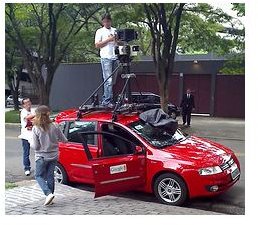Google Earth Street View Incidents
How do they do that?
Every wonder how Google gets all those pictures for Google street views? Some super-high tech satellite? Maybe they tap into the traffic cameras that have become common almost everywhere? You might be surprised to know that they use a considerably lower tech solution; people driving around in unmarked cars or trucks with digital 360° cameras on top, taking pictures from every angle. Combined with the satellite imagery, of course. If you look carefully, you can see that the images are not always taken at the same time. The light may be different, the cars may be parked in a different spot, or maybe a renovation has been done that makes the building itself different when you change angles. In one case, a gas station was captured from every angle, and it was completely rebuilt from only one.
Photo Credit: Flickr: Racum
Privacy issues and Google Earth street view incidents
The practice of driving down the street taking pictures of places has raised questions and challenges in a number of countries, and the number of Google Earth street view incidents caught on film only punctuates public and privacy watchdog organization concerns. In on scene, a man was photographed ogling a woman as she bent over to stretch. In another, a man was captured sleeping on the curb after a long night of drinking. These little embarrassing moments are bad enough, but some situations could be downright dangerous. Pictures of women entering or leaving abortion clinics or battered women’s shelters, or of people leaving an adult video store or being handcuffed by the police. The potential scenarios for public humiliation are endless.
Some argue that these are public moments, and that there is no real privacy in this world of camera phones and traffic cams. But the question, and often the embarrassment, remains. One picture doesn’t tell the whole story, and a career could easily be lost over unjustified public humiliation or even mistaken identity. Another thing to consider is uncovered windows. How many pictures on Google Earth capture people inside their own homes through the window? Google is willing to take these pictures down, but they must be identified and reported first.
Google’s cooperation
Google Earth has a reporting feature that allows any user to object to a photo and ask that it be taken down. Women’s shelters and certain other types of establishments that depend on secrecy are removed from the database, and details, like faces and license plate numbers are blurred. These measure are meant to cut down on Google Earth street view incidents, but it’s easy to imagine that a markedly embarrassing incident might be viral internet fodder seen by millions before the subject finds out, much too late to counter the damage.
Reporting a Problem
Google Earth’s reporting feature is straightforward and easy to use. If you find an objectionable photo, click “Report a problem” on the bottom left corner of the image. A selection box will come up and ask you to choose a category:
- Privacy concerns
- Objectionable content
- Other
Choose a category, fill out a short form and submit. Google will take it from there.
2010 Controversy
A new Google Earth controversy hit the news in 2010, after three years and numerous visual privacy concerns. Google revealed that the electronic gadgets in the photo-capture videos had captured data from unsecured wireless internet systems. As the vans, cars or bicycles went by, Google was able to capture unencrypted emails, video, audio and photo downloads, internet browsing and any other digital information being passed through any unsecured wireless network. Google called it an accidental data grab and apologized, but authorities in over a dozen countries launched investigations to determine whether Google broke privacy laws.
Brian McClendon, vice president of engineering for Google Geo, stated that “Our cars will no longer collect any Wi-Fi information at all, but will continue to collect photos and 3D imagery as they did before.” The real questions, though, are why were they collecting Wi-Fi information in the first place…and how extensively have we been compromised?
